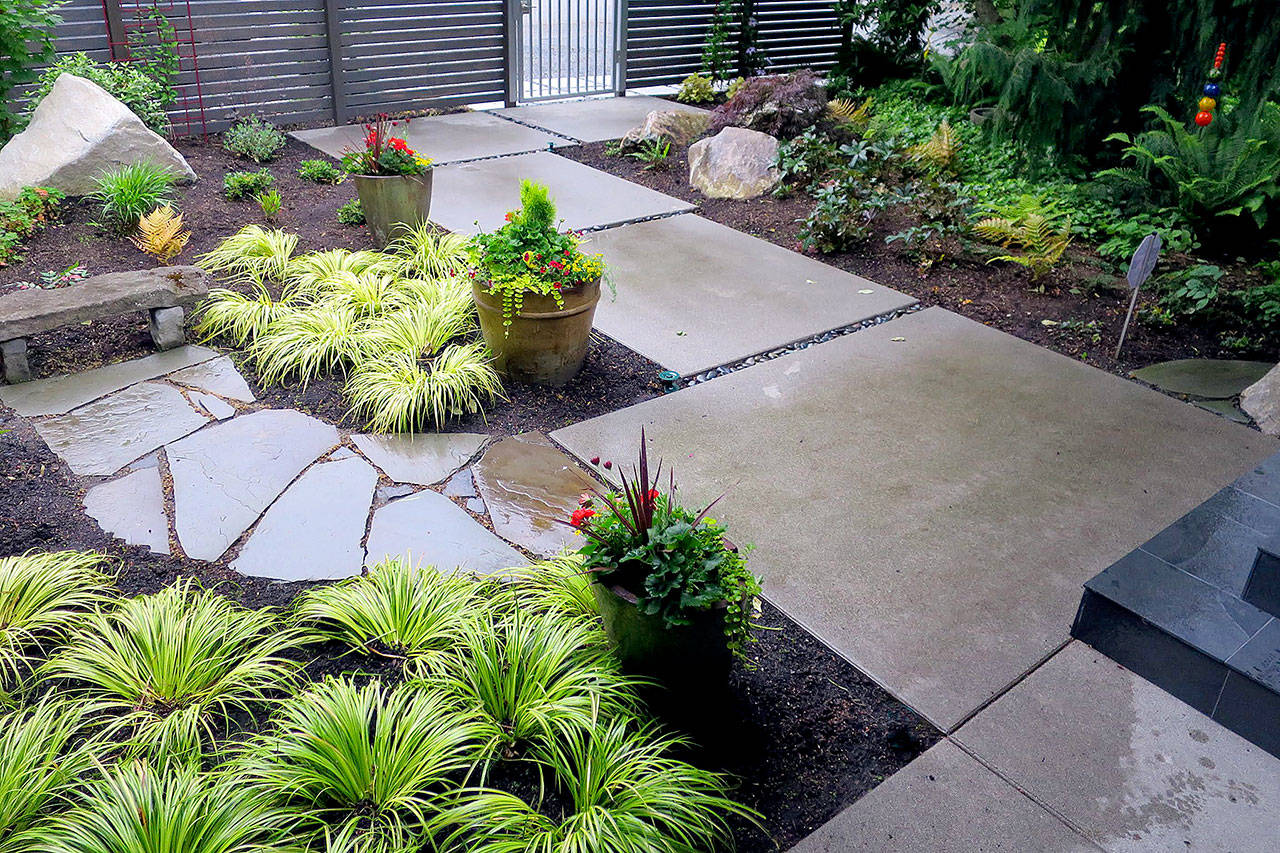Ah, the allure of a lush, green lawn.
It entices one with dreams of taking shoes off and lazing around with a good book or taking an afternoon nap on a sunny day. It can be an inviting place for family picnics or a social game of badminton. A healthy lawn can also act as a big sponge, soaking up water and possibly reducing runoff.
Yes, in the right place grass can seem appealing.
Let me repeat: “In the right place.” We’ve probably all seen or perhaps even tried to grow lawn in areas that just never seem to develop that lush appeal.
Some recent clients of mine moved into a home with a scrappy, struggling lawn in their front yard. It was on the north side of the house, receiving only morning sun. A tall cedar tree and native dogwood tree added to the shade. The dropping needles from the cedar also changed the pH of the soil to a more acidic level than grass can tolerate. No amount of water or fertilizer seemed to help.
It was simply not the best location for a successful lawn.
As we discussed what to do with the area, the homeowners listed their priorities regarding their outdoor space. In deciding to remove the lawn, it became clear that they had more reasons for not wanting to have grass than just the inhospitable location.
Watering: Lawns can require regular watering, possibly consuming much more water than a landscape planted with drought-tolerant or native plants. Providing a lawn area the 1 inch of weekly water it needs during summer months uses about 125 gallons of water per 1,000 square feet of lawn.
Pesticides and herbicides: Grass can be invaded by a variety of weeds. It happens. To control those weeds, many types of herbicides are frequently used. These herbicides can run off into the stormwater system and become washed into nearby lakes and streams and eventually into Puget Sound, contributing to pollution. Pesticides and herbicides can also have negative consequences for beneficial insects that are a natural part of the ecosystem. Use of pesticides may also be of concern if children and pets use the lawn.
Mowing: Some folks love to mow their lawn. Others (including me) find it a chore they would rather not have to do. Mowing with gas-powered mowers also results in carbon emissions that may be of concern. Push and electric mowers avoid this, though they can take more effort.
The above-mentioned homeowners decided to replace their lawn with a variety of plants that offer year-round color and textural variation. They also wanted plants that would provide benefits to birds, butterflies and other beneficial insects. So we got to work.
The plan: A tier of varying heights to add visual interest as well as creating habitat. Including native plants in the planting plan added plants that would need less maintenance and adding drought-tolerant plants also cuts down on watering where lawn is being converted to plantings.
Native ferns and salal were planted in the shadiest areas of the front yard. A native ground cover plant, mahonia nervosa was planted, at the right spacing to fill in over time.
The mahonia (common name Oregon grape) provides seasonal interest with yellow flowers in spring, followed by blue/black berries that offer food to birds. During winter months, the foliage takes on a colorful burgundy hue. Once established the mahonia will become drought-tolerant.
The new plants will need to be watered during their first few growing seasons, but once established will need very little supplemental water.
As we planned to covert their lawn to planting beds, I also went over other design features and best care practices with my clients. Here are some:
Sun: It is important to evaluate the amount of sun the area receives when planning planting beds. Be sure to plant sun-loving species in those sunny areas and select plants that tolerate shade in the areas receiving less sun.An example of a ground cover to replace lawn that tolerates sun is mahonia repens (a variety of Oregon grape). For a shadier area, another variety of Oregon grape, mahonia nervosa is a better choice.
Order: Another important design consideration in changing from lawn to plantings is creating a sense of order. A well thought out design can avoid the hodgepodge jumbled look of a multitude of different plants. Plants grouped in drifts or masses such as ornamental grasses can help avoid this. Repetition of a particular variety of plant also adds unity.
Paths: A well-placed path can provide the sense of flow that a lawn gives and can be a feature that helps to connect the various parts of the area visually and functionally.
Weeding: No mowing means no more yard work, right? Well, not exactly. Newly planted areas will need to be weeded until the plants fill in. Weeds need to be kept away from shading the new plants as they grow. Once the plantings have filled in, less weeding will need to be done. Space your plants accordingly to allow them to fill in within three to four years.
Compost: The sod that’s removed from your yard can be composted on site, if you have room for it. Once it breaks down, the compost can be added back into the garden beds to act as fertilizer for the new plants.
Pam Roy of Planscapes is an award-winning landscape designer with over 30 years of experience Contact her via info@planscapesdesign.com or 425-252-9469. For more information, visit www.planscapesdesign.com.
Talk to us
> Give us your news tips.
> Send us a letter to the editor.
> More Herald contact information.


























